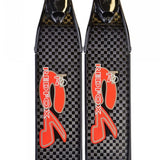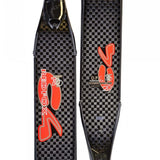TECHNICAL DATA
MATERIAL: 100% carbon fiber T700 PERFORMANCE
BLADE DIMENSION: 870 x 195 mm
BLADE HARDNESS: 25 soft – 30 medium – 40 hard
WATER RAILS: Constant h10mm
FINS ANGLE: 29°blade + 3°footpoket = 32°
FINS WEIGHT: from 600gr. up to 730 gr.
FOOT POCKET WEIGHT: 316 gr. in size 40/41
300 FOOTPOCKET SIZES (Black):
European sizes: 36/37 - 38/39 - 40/41 - 42/43 - 44/45 - 46/47 – 48/49
US/Canada sizes: 4/4.5 – 5.5/6 – 7/8 – 8.5/9 – 10/11 – 11.5/12.5 – 13/14
T700 CARBON FIBER
A standard stiffness (Tensil Modulus) combined with a 40% higher resistance (compared to the standard) makes T700 High Tensil carbon fiber particularly suitable for more reliable and durable fins. This new line of fins by C4 is manufactured with this T700 composite material. This line of new fins are manufactured with a standard elastic modulus (ability and speed of the material to return to its original position after having been bent) and high resistance (to breakage) carbon fiber. In addition, we have introduced the new large square fabric texture whose fibers are 5 times bigger to improve the performance. The wide bands of the weaving of the T700, compared to traditional carbon fiber cloth, reduce the number of total weaves. Weaves create friction and bend the extremely thin wires of the fiber. Friction and bends, generate negative effects on the performance of the blade. Reducing this effect, by using T700, results in a higher resistance and much better elastic return of the blades, generating more efficiency (more push and less fatigue) when diving.
300: HYDRODYNAMICS
Hydrodynamics: an efficient performance is based on resistance reduction. 300 fins elegant shape could have easily been designed by lines of water flowing on your feet without interruptions and only ongoing smooth lines. Hydrodynamics is key to reduce divers’ fatigue and these footpockets shiny look combines beauty and performance.
300: SAFETY & TIME
Blades are connected to the foot pockets by two special Hilo screws, for a better mechanical seal and energy transmission. This mechanical solution, in addition to making blades replacement much easier, prevents blades from being over stressed.
29° + 3° = 32°
The design of modern fins is mainly focused on achieving a better performance by increasing the total angle between the foot and the fin blade. The foot pocket blade angle must be amplified. In case of a low angle, stiffness of blades will result in fins with a reduced performance. Softer blades with a wider agle will result instead, in stiffer fins. C4 footpockets do not create this problem; all C4 anatomical footpockets have a 3° angle. The blade angle is 29°, a value much used on modern fins which determines a greater preload, making the blade more reactive. Such 29° solution, reaches an angle of 32° thanks to the 3° angle of the patented C4 footpockets providing for an excellent kinematic performance.
ONCE UPON A TIME
In the past, to dive at very high depths, fin blades, longerons and foot soles had to be extremely stiff. This was the only way to achieve performing fins. Nowadays, blades are soft and performing, therefore modifying the divers’ athletic movement as less effort is required. This is diving, not skiing and not even climbing, where strength is key. Modern blades can bend under few hundreds grams. Stiff foot soles and footpockets are not necessary any longer as they even limit divers’ performance. C4 goal has always been to create products which allow for a fluid and constant movement in water. As a matter of fact, footpockets must serve divers helping them to freely move their feet. This is why C4 300 foot pockets’ calibrated stiffness, in combination with modern soft and angled blades, offer an amazing swimming experience. This is what modern divers require, nothing more than that: a really efficient performance.
D.P.C. Double Parabolic Curve
The blade works best when it bends completely? From heel to toe !! This is possible thanks to the double parabolic curve of blades, from heel to toe. A neutral intermediate bottom and two progressive declining curves. Thus it fully exploits the shovel and its elasticity.
CONSTANT WATER RAILS
Fin blades, in areas where water rails are not present, disperse 50% of the water they come in contact with. This is what the French call “drifting”. We make an effort to move water for thrust but we disperse it on the side. Therefore the forward thrust is low, and the action useless. The solution to this problem was invented in 1993. Constant water rails, inspired by racing car spoilers, were invented to keep water on the blades and not disperse it on the sides. Divers feel as if they were kicking on two rails. Water is not side channeled, blades do not twist and system efficiency is outstanding. Especially indicated for freediving deep dives, where constant speed is key compared to acceleration.
CONCAVE SHAPE
Blades concave shape pushes water flows towards the blade core. This provides fins with immediate elastic reaction to the movement coupling, allowing rapid restarts, therefore resulting in excellent energy transmission.
MADE in ITALY
C4 has over thirty years experience in designing and manufacturing advanced carbon fiber equipment, in Italy. Our history is at the base of our brand success.




